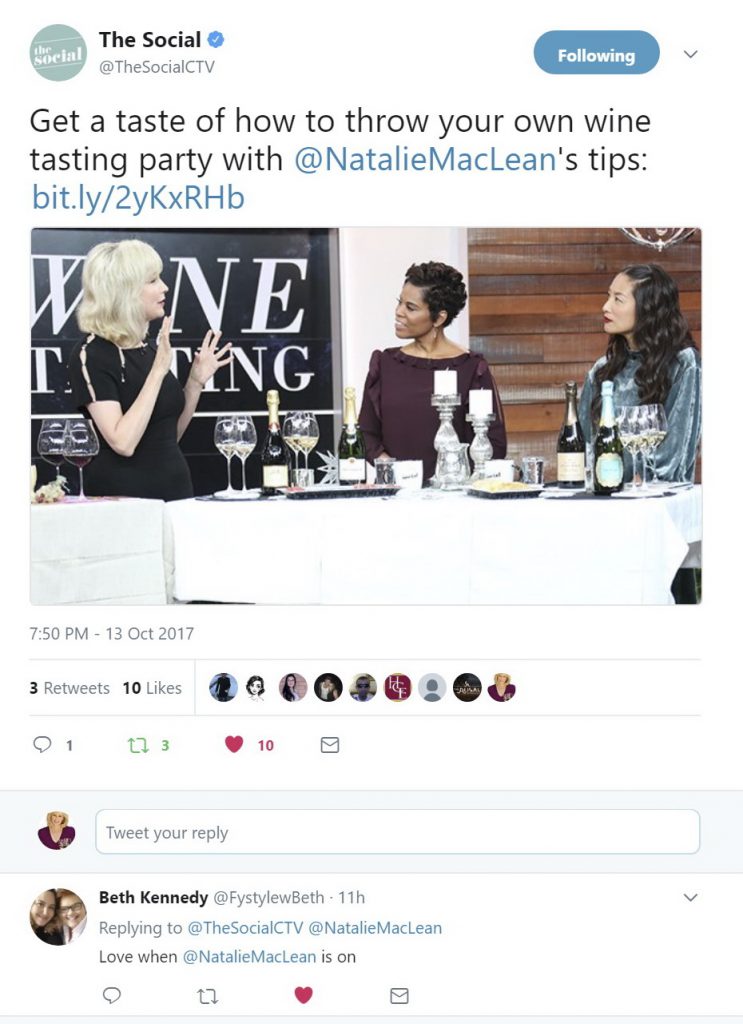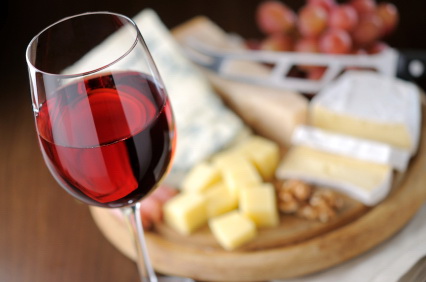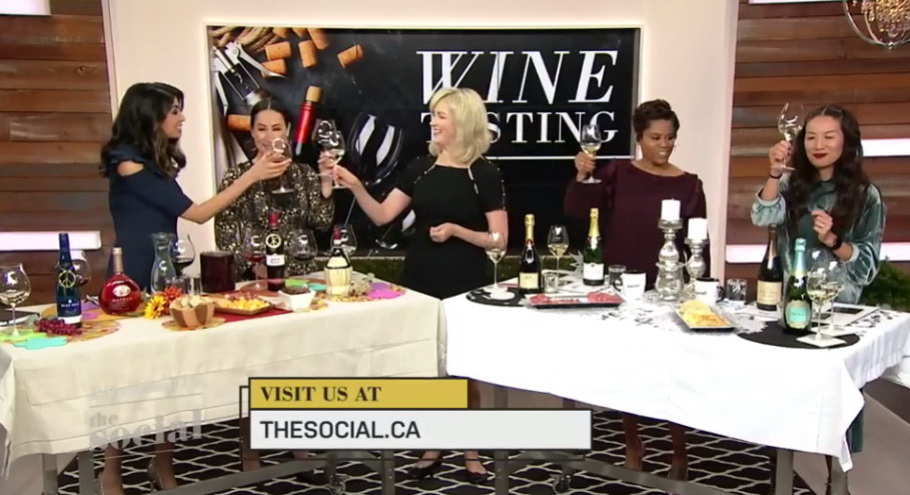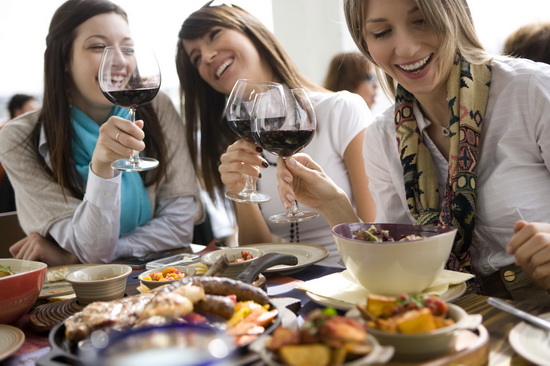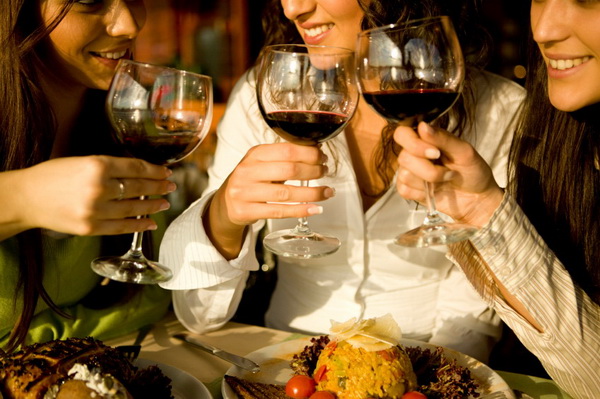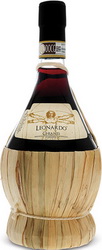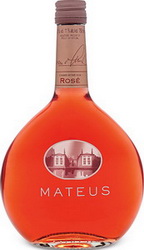We had such fun on The Social yesterday chatting about how to organize an informal wine tasting party at home.
There are many excellent reasons to host a wine tasting party—or even to form a wine club. For one thing, wine is a social beverage—one that’s meant to be shared with friends.
And it’s more fun to drink than to buy Tupperware—unless, of course, you’re drinking from the Tupperware. The only goal is to enjoy yourself and perhaps find a new favorite bottle.
Although wine does lend itself to serious technical analysis, that’s not really necessary. You don’t need a PhD to talk about it: anyone can share opinions about the wine.
Villa Conchi Brut Selección
Cava D.O., Spain
Most people just want to socialize over a good glass or two (or three); though it’s a bonus if we can learn something too.
Wine can also kick-start the conversation—it’s something that people can talk about, especially when they’re meeting each other for the first time.
Tasting with friends, in your home or theirs, is usually less intimidating than going to formal events.
For starters, you don’t have to wear a tweed jacket or listen to discussions on how the 1956 September rains ruined the riesling fruit set in the Rheingau.
You also get to decide on the day, the time, the theme, the accompanying food, the people and the cost of the wines.
Wine tastings can be a great way to get to know your neighbors, perhaps by inviting them over for a barbecue and matching big red wines.
Tastings can also be a creative twist on holiday cocktail or dinner parties; they’re usually less work than setting up all the ingredients for a cocktail bar or cooking a full meal.
But if you plan to throw a dinner party anyway, why not serve a flight of wines—several at once rather than one glass at a time? (Just remember to moderate what you pour, with two to three ounces of each wine instead of a full glass.)
With tens of thousands of wines on store shelves, the choices can be overwhelming. You have to kiss a lot of frogs to find a prince, that delicious and reasonably-priced bottle. Group tastings maximize your wine budget since you can sample six to eight wines for the cost of the one bottle you bring to the group.
Santa Margherita Brut Valdobbiadene Superiore Prosecco
Veneto D.O.C.G., Italy
Tastings can also help you select wines for weddings, parties and holidays such as Thanksgiving, Christmas and Hanukkah. You can even use a tasting to choose the bottles to help stock a newlywed couple’s first cellar or to lay down for your baby’s 21st birthday.
The first step in hosting a tasting is to choose who you want to invite. I strongly suggest picking only people you like. Beyond that, gather those who share the same knowledge level of wine. (If one person happens to be very knowledgeable, make sure he or she isn’t an insufferable bore who’ll dominate the conversation.)
Some groups occasionally invite a guest expert to begin the tasting, then follow the formal talk with informal group discussion.
Ideally, invite between six and twelve people: a good number to have a lively conversation and to sample between six and eight bottles. (You don’t want everyone inebriated by the end of the night unless you have a guest house that sleeps twelve.)
Over the course of two or three hours, your guests will probably consume two to three five-ounce glasses of wine—about half a standard 750 ml (26-oz) bottle. Tasting samples of two to three ounces each are just enough to get a good sense of the wine. This increases the number of wines you can try: between six and twelve people can share a single bottle.
The wines you choose will depend on whether you prefer a “vertical” or “horizontal” tasting. This doesn’t refer to your position while you drink as the night wears on. Rather, it means comparing wines by variables, such as grape, region or year.
Taittinger Brut Reserve Champagne
Champagne A.O.C., France
For example, if you compare a selection of Australian shirazes from different wineries, that’s a horizontal tasting. But comparing the shirazes of one Australian winery for each year from 1998 to 2004 is a vertical tasting.
Similarly, trying shiraz from Chile, California and Australia made in the same year is a horizontal tasting, as is sampling shiraz with other red wines such as cabernet sauvignon, merlot and zinfandel.
You can get even more particular by comparing shirazes from the same region, some of which are oaked and others which are not. This side-by-side comparison allows you to taste how certain variables affect the wine and which you like best.
But these are advanced tasting techniques; at the beginning, your best bet is to keep it simple and low-key, so that no one is intimidated.
Other ideas for themes include asking everyone to bring a memorable bottle and share its story—perhaps they drank it to christen their first apartment or on a wonderful trip to Italy.
Another is to choose wines that break stereotypes, such as the myth that the only good Canadian wine is icewine. (Try Canadian pinot noir and riesling—they’ll knock your socks off.)
Jackson-Triggs Sauvignon Blanc Sparkling
Niagara Peninsula, Ontario V.Q.A., Canada
Or just have fun with a retro 1970s tasting, to see if groovy tipples such as Mateus, Blue Nun, Piat d’Or and Black Tower have changed since then? (More likely, your own taste has.)
Send invitations on psychedelic purple paper. Get out the lava lamps, love beads and long lapels; play those old favorites such as The Lion Sleeps Tonight; and have a fondue.
Food matching is also a great way to theme a tasting: deciding which wines go best with seafood, cheese, desserts, hors d’oeuvres and so on.
The food doesn’t have to be elaborate; nibbles are fine. Opt for dishes that aren’t too spicy or hot since these can numb the palate—unless, of course, you’re trying to find the ultimate wine for a fiery Madras curry.
Another option is the “blind” tasting, at which you brown-bag all the wines and taste them without knowing their identities until the end, when everyone votes on a favorite.
Guests can rank them in order of preference, with a score of one to ten—or even play the Roman emperor, giving the vinous “combatants” a thumbs-up or thumbs-down. (In the end, they’ll all go down without a struggle.)
As the host, you might want to throw in a Chilean cabernet among those from California, for example, to see if guests can identify the “ringer.”
Moving on to practical matters such as cost, your group can determine how much to spend on the wines. In fact, sticking within the same price range for all the wines is a better way to compare them than pitting a $10 wine against one that costs $50.
Once you’ve agreed on the budget, you can decide whether the host buys all the wines and is reimbursed or whether each person or couple brings a bottle to each tasting.
Another consideration is stemware: six to twelve people sampling six to eight wines apiece means a lot of glasses. You can cut down somewhat by trying two flights or two sets of four wines at a time and then simply rinsing and reusing the glasses for the second flight of four wines.
But if you want to try all the wines at once, there are several options. Guests can bring their own glasses from home, you can rent glasses for the occasion from a party rental shop or the group can pool funds to buy glassware for the tastings.
Choose tulip-shaped glasses that concentrate the aromas of both red and white wines and allow you to taste them more easily.
Blue Nun Rivaner
Rheinhessen, Germany
Those itsy-bitsy golf-ball-sized glasses that you often see in restaurants are useless and the fancy large glasses the size of fish bowls are clumsy and take up too much space on the table.
All that glassware may not fit on your coffee table so you may prefer to taste the wines at the dining table. Then afterwards, you can retire to the living room for tea, coffee, dessert and more conversation.
One of the less sociable aspects of wine tasting is expectorating—spitting out your samples. Nobody should have to swallow wine they don’t like or be forced to drink too much. And even if you don’t have a white carpet, you’ll want to give your guests something in which to spit.
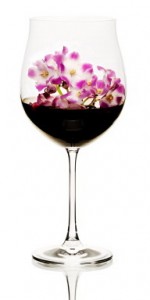 For this charming tradition, you’ll want some version of a spittoon on the table, whether it’s a central ice bucket or individual glasses or mugs. (Opaque rather than clear preserves the much-needed illusion of delicacy.)
For this charming tradition, you’ll want some version of a spittoon on the table, whether it’s a central ice bucket or individual glasses or mugs. (Opaque rather than clear preserves the much-needed illusion of delicacy.)
Some guests may think this habit as appalling as spitting out their food, but you can help to remove the social stigma by explaining that it’s perfectly acceptable and that you can taste more wines if you spit rather than swallow. (Though in a social setting, a force stronger than gravity makes most of us want to swallow whatever is in our glass.)
It’s also important to make sure that everyone has a glass of water. Not only is alcohol dehydrating, but guests won’t drink as much wine if they have water to slake their thirst.
Leonardo Fiasco Chianti
Italy
And now on to the fun part: tasting the wine. There are four basic things to look for when you taste wine: look, smell, taste and finish. The first means you need good light—though of course that’s a balance between creating a cozy social setting and being able to see what you’re doing.
Candlelight isn’t ideal for judging the color of wine, but you also don’t want a harshly-lit lab-like environment. Look at the wine tipped on its side against a white tablecloth, or even a piece of paper, to tell how clear it is, or whether there’s anything floating in it.
You can also see how old it is. Young whites are usually green at the edges and become a deeper yellow or gold with time; reds are usually purple or ruby in youth and turn to garnet or brick in age. Avoid holding your glass up to the light though—this tells you little other than how many colors the wine can reflect from the wallpaper.
Mateus Rosé
Portugal
Next, give the glass a swirl and inhale deeply. Don’t be shy about this inelegant task: get your nose well inside the glass. Since wine’s aromas are volatile, smell is considered the determining factor of wine character.
In fact, we can detect more than two thousand aromas with our noses, but only five tastes in our mouths (sweet, salty, bitter, sour and a savory character called umami). Try sipping wine with your nose plugged and you’ll taste the difference.
What do the wine’s aromas remind you of: wood chips, cherries, apples, your Aunt Mildred’s spice cake? This is a subjective judgment that becomes sharper with time and experience. This is a good reason to get rid of competing odors: ask guests not to wear strong perfume or cologne.
Now taste the wine. Swirl it around your mouth and aerate it by sucking in a little air through your mouth to further enhance the taste. (You may want to practice this in the shower at home first—or at least, don’t wear white the first time you try it.)
Black Tower Pinot Noir Dornfelder 2016
Rheinhessen, Germany
Think about not only what flavours you detect, but also how the wine feels in your mouth: heavy as cream, light as skim milk or somewhere in between, like whole milk?
Finally, swallow the wine to see how long the flavour impression lasts—its finish. A long finish means you can still sense the wine in your mouth for eight seconds or more after swallowing.
A medium finish is four to seven seconds and fewer than four seconds is short. The longer the finish, the better.
Wine tastings are one of the simplest, yet most enjoyable ways to entertain. They can be as educational or as hedonistic as you like.
They can accommodate just about any budget, theme, occasion or taste. All that’s necessary are good friends to share them with. Cheers!
Continue to The Checklist for How to Host a Wine Tasting
1/ HOST – WHY HOST A WINE TASTING
What would you say to people who might be intimidated to do a wine tasting?
· Tasting with friends in your home is a less intimidating way to try new wines than going to formal events. You won’t have to impress anyone with your knowledge of grape varietals or terroir; you can simply enjoy yourself and find a new favourite bottle.
· Wine tastings can offer a great twist on holiday cocktail or dinner parties because they’re usually less work than setting up a full cocktail bar or preparing a large sit down dinner.
· Tastings can also help you select wines for weddings, parties and holidays.
WINE TASTING TIPS
2/ HOST – TIMELINE
Let’s get to some of your tips. You say about a month before the event there are a few things you should decide. What are they?
· Decide who you want to invite. Your tasting could be for existing friends or a means to get to know new friends via work or other venues. Keep the guest list relatively small. Six to 12 people is plenty.
· Set the date. Tastings can be held on weeknights though many people feel more relaxed about tasting wine on a Friday or Saturday.
· Set the time. Wine tastings take two to four hours, depending on how you’re hosting it. If you’re doing dinner, allow for up to four hours for the tasting. If you’re just doing a few nibbles, chances are it’ll be a two hour affair.
3/ HOST – CHOOSE A THEME
Next you suggest we choose a theme. As everyone can see we have two very different setups here. How do you come up with ideas?
· You can decide if you want to do a “vertical” or “horizontal” tasting.
o A vertical tasting takes one specific wine, such as say Kim Crawford Pinot Noir, and you’d taste various vintages ie 2016, 2015, 2014 and so on to see how the wine ages and how vintages varied with different weather conditions etc
a horizontal tasting could have say the Kim Crawford Pinot Noir from 2016, and then compare that to other New Zealand Pinots from the same vintage, or even other Pinots from other regions, like Canada and the US from 2016 … this is more to illustrate the stylistic difference between the wineries when it comes to one wine all from the same vintage
o Keeping wine variety and wine regions the same helps emphasize differences in winery styles.
· You can keep it simple and have everyone bring a memorable bottle and share its story.
· You could choose a themed party like we’ve done here. I decided to do retro wines and style it with a 70s theme and a glitter theme with various sparkling wines.
4/ HOST – FOOD PAIRING
What about foods at a wine tasting? Does your food have to pair well with all of the wines?
· The food doesn’t have to be elaborate; nibbles are fine. Opt for dishes that aren’t too spicy since they can numb the palate and overwhelm the wine.
· Suggested nibbles include cheeses, nuts, salmon and pate. Entrees include chicken in a cream or tomato-based sauce, pork, steak and pasta. Be aware that seafood can clash with red wines.
· Also think about your theme. We’ve opted for fondue with our 70s table because it fits into the overall retro experience.
5/ HOST – OTHER ITEMS
What else do we need to provide at a wine tasting?
· Make sure there’s a piece of paper or notepad and pen for each person so they can jot down tasting notes or the names of their favourite wines.
A handy alternative is a wine mobile app like the one I created that allows you to scan the label or barcode of the wine, save it in your virtual cellar and share it on social media.
· Count on one glass per wine per person, unless you plan to reuse the glasses for different wines. Just make sure to rinse them out between each pour. Set the glassware in a row or semi-circle in front of each place.
· No one should have to swallow wine they don’t like or be forced to drink too much so make sure you include a spittoon on the table. You can use a central ice bucket for everyone or individual glasses or mugs (opaque rather than clear preserves the much-needed illusion of delicacy).
· It’s also important to make sure that everyone has a glass of water. Not only is alcohol dehydrating, but guests won’t drink as much wine if they have water to quench their thirst.
6/ HOST – TASTING THE WINE
Let’s get to the actual tasting – where do we begin?
· There are four basic things to look for when you taste wine: look, smell, taste and finish.
· With each step, you’ll want to make sure you’re starting an informal discussion with the group by asking good questions.
o What do you see, smell, taste?
o Do you like the wine? Why or why not?
o Do you think it would pair nicely with a particular flavour or dish?
· Prompt your guests to take notes and write their overall impression of the wine.
7/ HOST – LOOK
Okay, let’s start with the look of the wine. What exactly are we looking for?
· First of all, you need good light. Candlelight isn’t ideal for judging the color of wine, but you also don’t want a harshly-lit lab-like environment.
· Look at the wine tipped on its side against a white tablecloth, or even a piece of paper, to tell how clear it is, or whether there’s anything floating in it.
· You can also see how old it is. Young whites are usually green at the edges and become a deeper yellow or gold with time; reds are usually purple or ruby in youth and turn to garnet or brick in age.
8/ HOST – SMELL
Next, we’re smelling the wine. I know you’re supposed to swirl the wine in the glass but why?
· Swirling the wine draws in oxygen from the air. When wine encounters oxygen it begins to break down or “open up,” giving off its aromas.
· Since wine’s aromas are volatile, smell is considered the determining factor of wine character. In fact, we can detect more than two thousand aromas with our noses, but only five tastes in our mouths (sweet, salty, bitter, sour and a savory character called umami). Try sipping wine with your nose plugged and you’ll taste the difference.
· Ask yourself what the wine’s aromas remind you of: wood chips, cherries, apples, your Aunt Mildred’s spice cake? This is a subjective judgment that becomes sharper with time and experience.
· It’s also a good reason to ask guests to refrain from wearing perfume or cologne so there are no competing odors.
9/ HOST – TASTE & FINISH
Now comes the tasting. Are we supposed to be gurgling it like mouthwash?
· Swirl it around your mouth and aerate it by sucking in a little air through your mouth to further enhance the taste. You may want to practice this in the shower at home first – or don’t wear white the first time you try it. J
· Think about not only what flavours you detect, but also how the wine feels in your mouth: heavy as cream, light as skim milk or somewhere in between, like whole milk?
· Finally, swallow the wine to see how long the flavour impression lasts – its finish. A long finish means you can still sense the wine in your mouth for eight seconds or more after swallowing. A medium finish is four to seven seconds and fewer than four seconds is short. The longer the finish, the better.
Posted with permission of CTV.



